The ASUS Zenbook UX305 Review
by Brett Howse on March 25, 2015 8:00 AM ESTGPU Performance
On the GPU side, the Core M-5Y10 has the Intel HD 5300 Gen8 graphics of Broadwell, but with clock speeds of 100 Mhz to 800 Mhz, as compared to the 5Y71 which has 300MHz to 900 MHz available. We have tested several Broadwell processors so far, and the Gen8 graphics are a reasonable boost over the Haswell Gen 7.5 model, with a bump in execution units (EU) from 20 on Haswell to 24 on Broadwell. The Yoga 3 Pro has the Core M 5Y71, which on paper should offer more performance than the 5Y10 based UX305 that we received for review.
One thing that became clear on the Yoga 3 Pro review was how even though the GPU was the same number of EUs as the Broadwell-U processors, and it has the same base and boost clock speed, the 4.5 watt window of Core M limited performance quite a bit. As we saw on the system performance already though, ASUS has elected to allow Core M to get hotter, so that may change the outcome on the GPU as well.
FutureMark 3DMark

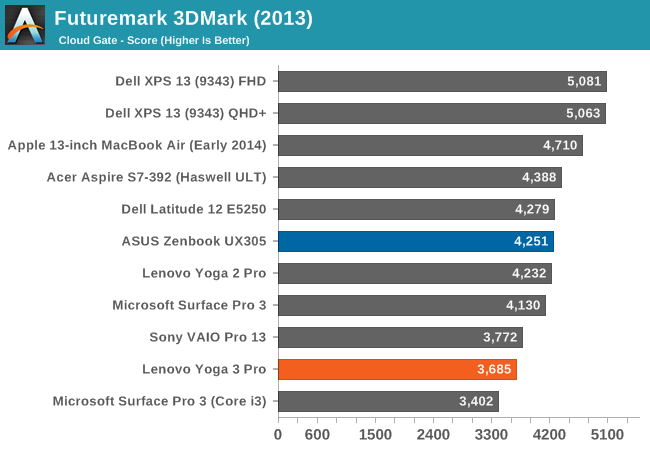
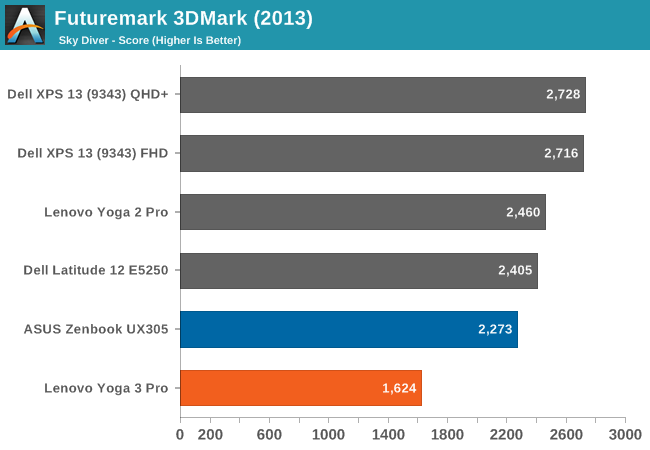

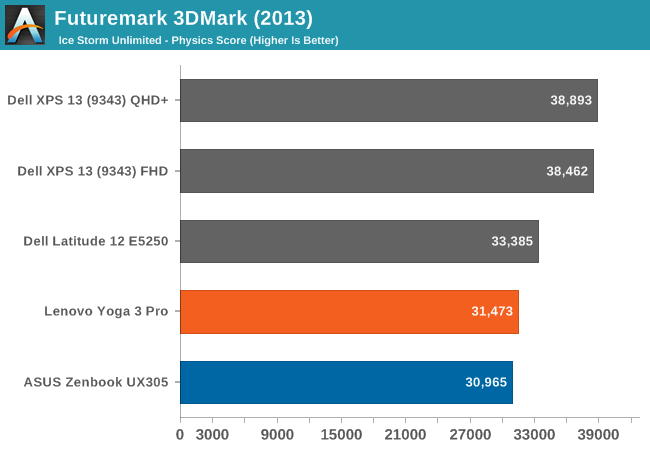
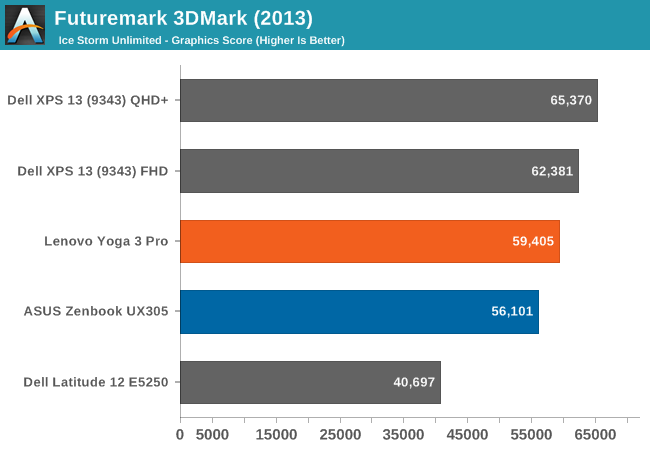
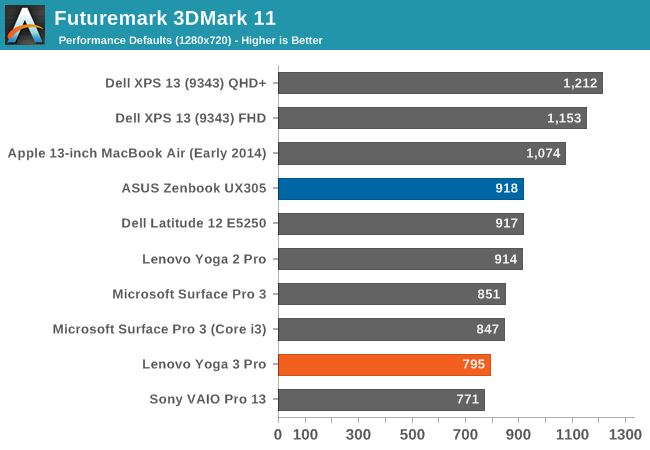
FutureMark has compiled several benchmarks in 3DMark 2013. All are a reasonable length, except for Ice Storm Unlimited which is more of a smartphone/tablet benchmark, and therefore completes very quickly on a PC. Here we can see how much more performance the ASUS UX305 can deliver over the Yoga 3 Pro, which again on paper has a faster processor. ASUS allows much more thermal headroom on the SoC, which results in considerably better scores when using the GPU. The exception to this is the Ice Storm Unlimited, which completes quick enough that the Yoga 3 Pro does not have to throttle as much.
GFXBench
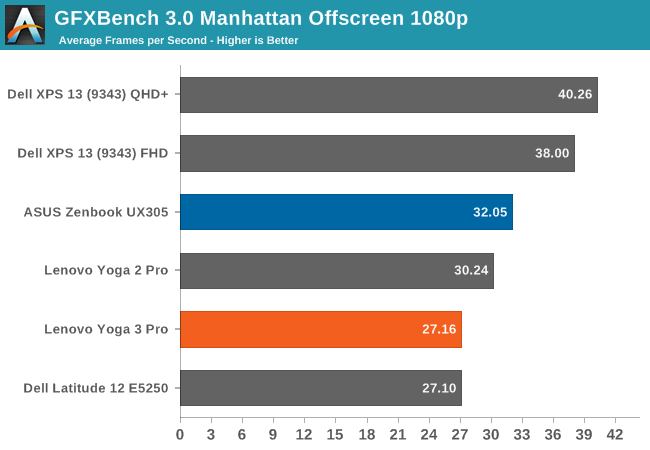
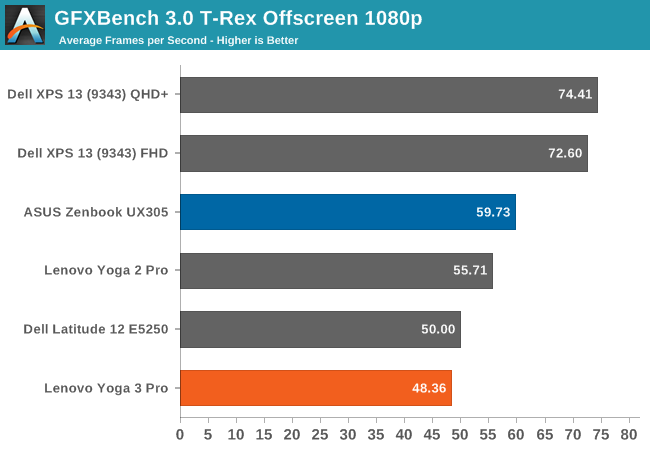
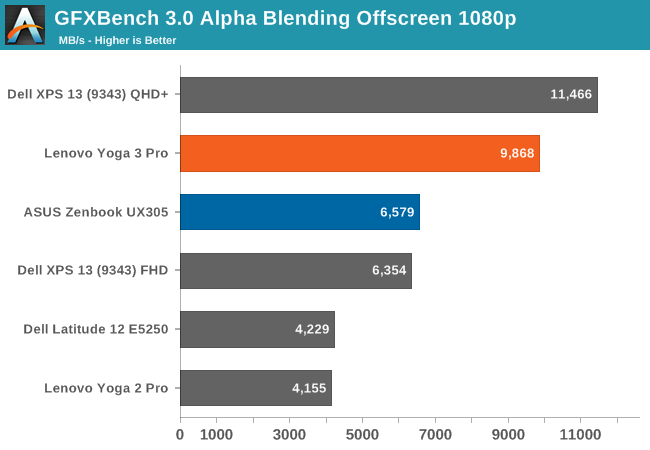
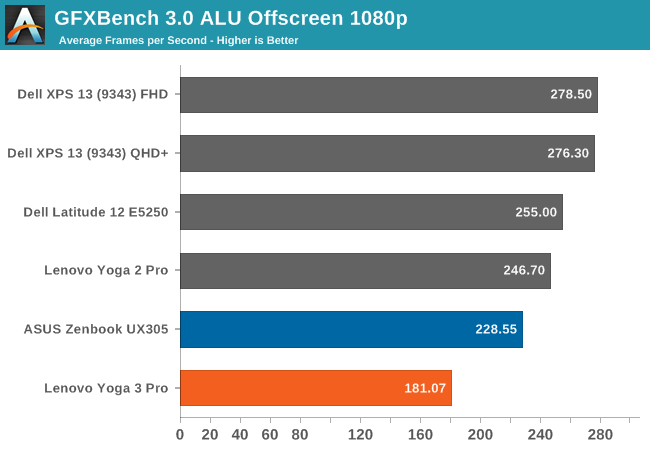
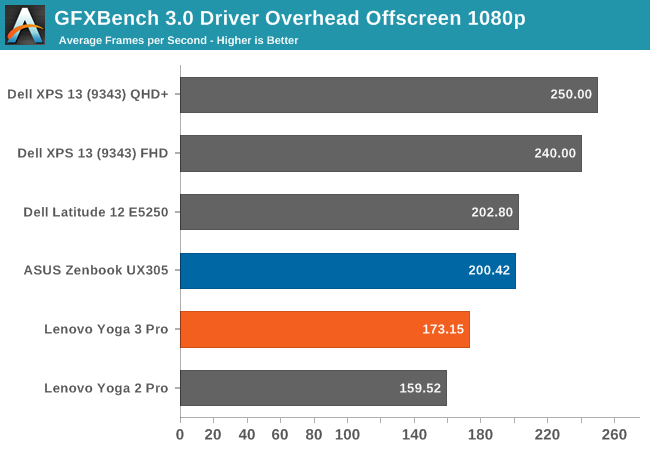
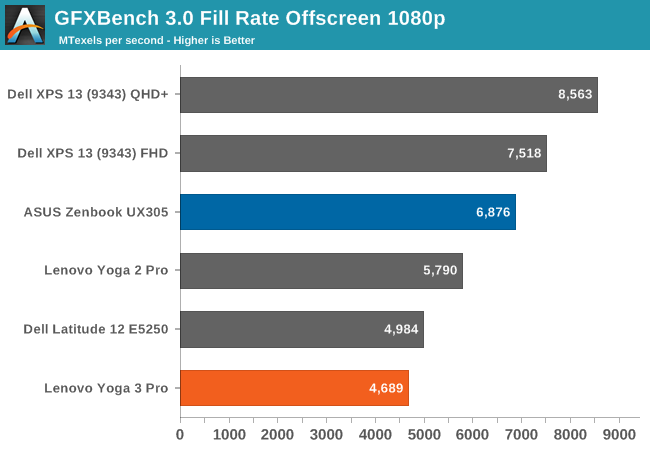
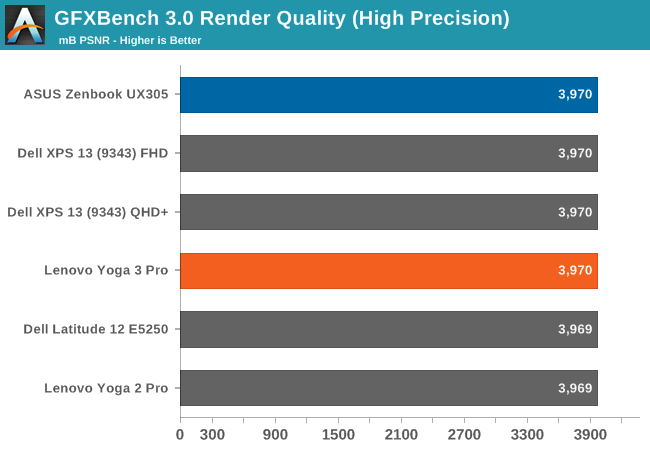
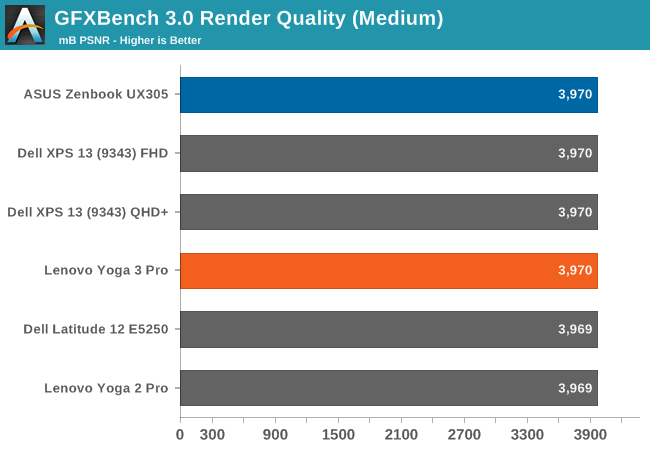
GFXBench 3.0 is available in the Windows Store, and is a DirectX version of GFXBench. On the two gaming benchmarks (Manhattan and T-Rex) we can see that the UX305 pulls ahead of both of the Haswell-U based devices in our graphs, which are the Yoga 2 Pro and the Latitude 12. The Dell XPS 13, with Broadwell-U, is still a lot more powerful which is not surprising since it has a 15 watt TDP compared to just 4.5 watts on Core M (Broadwell-Y). Once again, we can see that the ASUS is stronger than the Yoga 3 Pro.
DOTA 2 Benchmarks
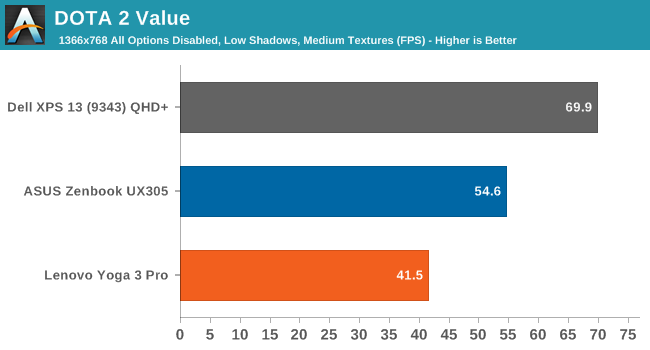
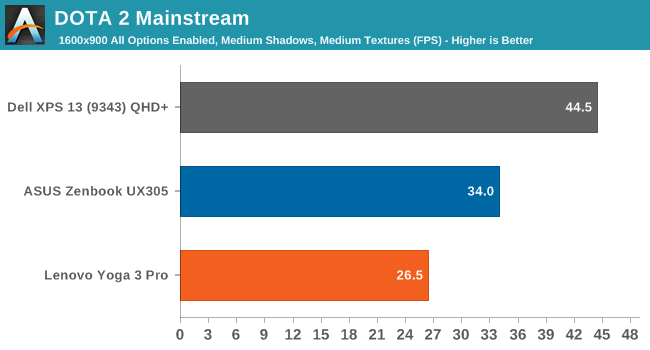
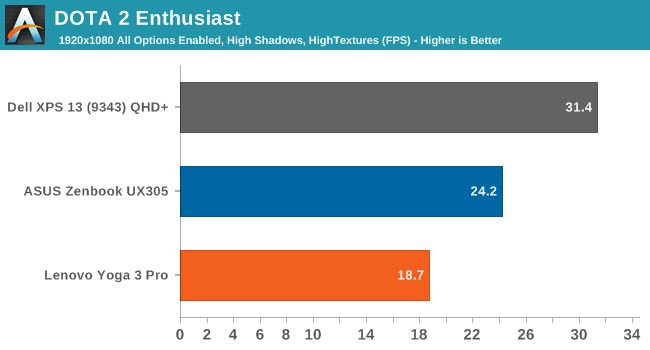
One area where the Yoga 3 Pro struggled was with our DOTA 2 benchmark, which is quite long in duration. We run at three different levels, and the Yoga 3 Pro fell quite far behind the Dell XPS 13. The ASUS UX305 closes that gap though, and gave a much higher frames per second than the Yoga 3 Pro.
Tablet Comparison
As with the Yoga 3 Pro, we will compare the ASUS UX305 to several tablets to see where Core M fits in the lineup. The UX305 is certainly not a tablet competitor unlike the Yoga 3 Pro, but the improved GPU performance seen in the laptop comparisons should give us some more information to about where the Intel graphics compare to the best SoC GPUs available today.
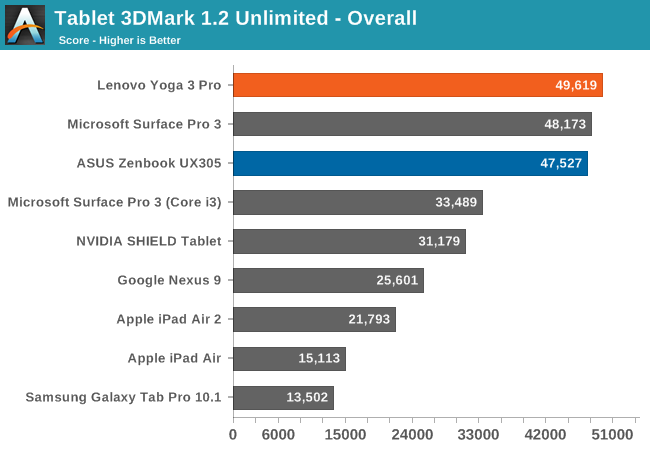
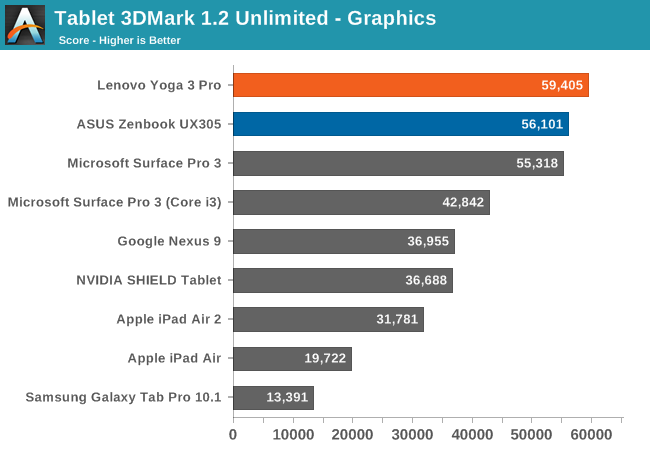

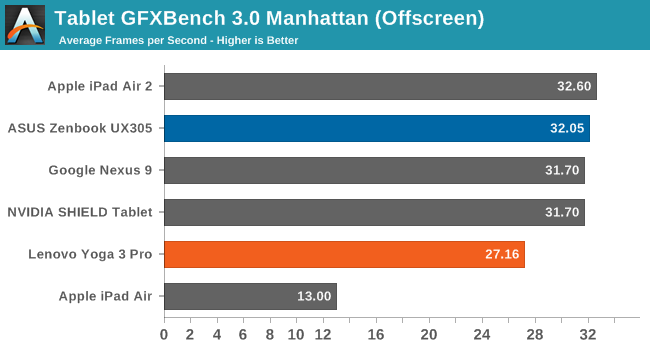
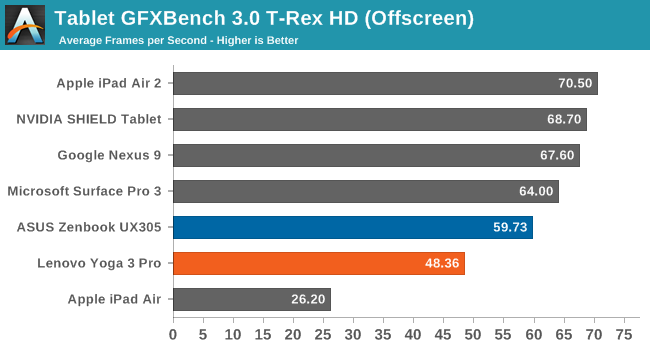


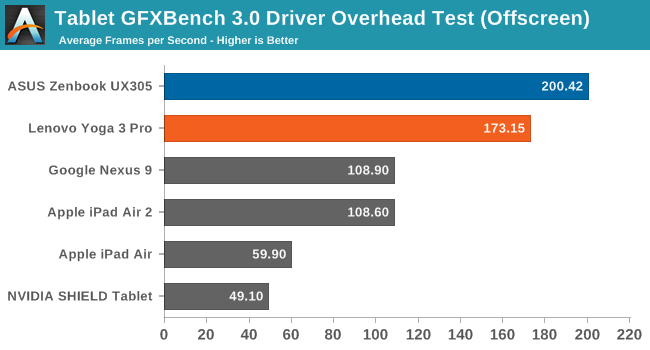
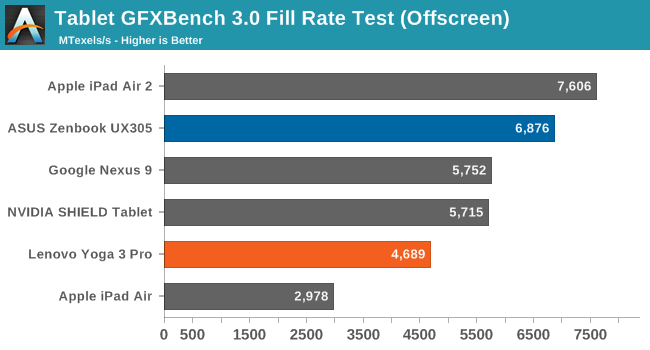
3DMark Unlimited shows the capabilities of the GPU, but is so short that the throttling issues we have observed do not come in to play. The Gen8 graphics of HD 5300 should certainly be able to compete favorably to any of the tablet SoCs if give enough headroom, however that is obviously not the case.
The GFXBench scores show that the Core M 5Y10 can compete with tablets, with it coming in very close to the same scores as all of the latest tablets on the Manhattan score. The T-Rex benchmark is much easier, and it falls behind a bit, but is still a lot quicker than the Yoga 3 Pro.
GPU Conclusion
The increased thermal headroom that ASUS allows on the UX305 has dramatically increased the GPU performance of Core M when compared to the Yoga 3 Pro. The device does get warm though, with it hitting close to 50°C at the top of the laptop, but it does not affect the keyboard or wrist areas. The lack of a fan makes these scores even more surprising, but Lenovo has opted to keep the surface temperatures a lot lower on the Yoga 3 Pro.
There is a lot to be said about Core M performance, and too much to put in this review. We will be doing a deeper dive into the performance of Core M and how it performs in various devices, both actively and passively cooled, as well as compared to Broadwell-U based systems which are a more traditional design. Clearly, there is a lot of factors that affect performance in a device such as this than just the label on the spec sheet.


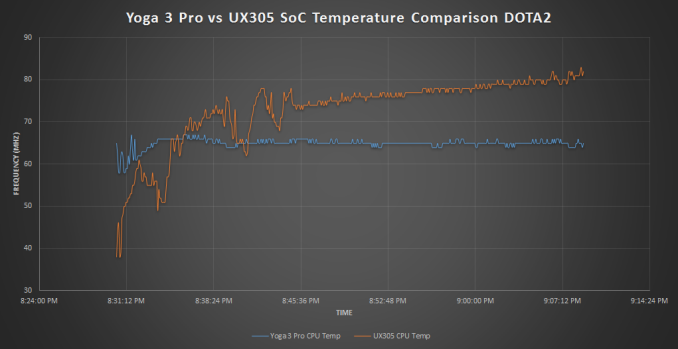








164 Comments
View All Comments
metayoshi - Wednesday, March 25, 2015 - link
I may be in the niche group right now, but I am pretty excited at what these 5W chips bring to the table. These chips are really where Windows on a tablet will stand out in my opinion. With much better performance than you get with the crappy Atom line of CPUs and with way better performance than anything ARM will provide, and then add in the millions of legacy programs that you can use on a full x86 Windows platform, and in my opinion, it's a winning combination. With products like Dell's Venue 11 Pro already upgraded to Core M, and with the upcoming Asus Transformer Book T300 Chi also coming in with Core M, and all for around $800, I find it worth the extra $300 to get better performance and get full blown Windows instead of being stuck in the limited Chromebook world. At this point, I'm waiting on reviews, and both of Anandtech's Core M reviews so far show me what I expected.Of course, I agree that this platform is not for everybody. A gamer should build their own gaming desktop, or invest in something like the Razer Blade if they want mobility, and a content consumer should just go Android Tablet, iPad, or Chromebook. But personally, I already have a gaming desktop at home that is overpowered for the task in my mind and would benefit from being mobile, but the task is incompatible with anything but Windows, so my smartphone or non-Windows tablet can't even run to program, and Atom is far too weak, so something with Core M is ideal.
In other words, if you don't want it, don't buy it. But to answer your top question, who asked for a 5 W notebook chip? I did.
eanazag - Monday, March 30, 2015 - link
I'm excited about these chips too because of battery life. For personal use I'd rather have some more gaming chops.I use a Surface Pro 1 for work and am happy with it except for battery life. The battery life isn't bad; I just know there is better out there and in consideration to my iPad I can't ditch the iPad.
r00fus - Wednesday, March 25, 2015 - link
Hyperbolic post is hyperbolic.Let us know how all your existing software runs on an ARM chip.
Go buy yourself a monster laptop if you want. I like having an option of a slim, sleek fanless form factor, even if the performance isn't top notch.
wetwareinterface - Wednesday, March 25, 2015 - link
because the MAINSTREAM of the notebook market won't even use the paltry power this offers. the MAINSTREAM user needs a web browser, a picture viewer, video playback software and at rare intervals the ability to run office. 8GB of ram means they won't need an upgrade for a long time.V900 - Thursday, March 26, 2015 - link
But after a couple of weeks the MAINSTREAM will start to get annoyed with the slowdowns, the heat and the fact that you can't have more than a few programs running at once, whitout the laptop throttling down constantly. MAINSTREAM is especially annoyed how everything comes to a crawl when they're doing the virus scans. Because 8GB RAM doesn't change the fact that the puny 5 watt ceiling means that it spends half the time below 1 GHZ and with one core turned off.MAINSTREAM quickly realizes that much of the time, their iPad does a quicker and better job at looking something up online, or replying to an email.
V900 - Thursday, March 26, 2015 - link
Hey now! Apple certainly didn't put this halfassed, asthmatic excuse of a CPU in the MacBook Air.It's the craptastic 12 inch MacBook that has to suffer the indignity of being powered by a CoreM.
(And while I love Apple products and got an i-everything myself, both Apple and Apple fanboys have finally jumped the shark with the 12 inch MacBook. And the Koolaid-swillers can't believe how innovative it is: "It only has ONE port! So brave and futuristic!"
akdj - Saturday, March 28, 2015 - link
It's also fabless, with PCIe storage that flat FLIES, an excellent iGPU that'll help that meager Core m processor that is essentially as fast as the quickest core2duos (mobile)! As well, an operating system that scales your UI properly and sure, a single port. It's 'portable'. Not meant to be connected.You can certianly (& already) buy the proper docks and/or adaptors necessary to utilize USB 3, HDMI or VGA, & power it simultaneously. The traditional bottleneck for the 'mainstream' has NEVER been the CPU. Rather it's memory, storage sub system, OS or a combination of all at the above...including GPU. While you're an Apple fan, you should know just how great these displays and their HiDPI scaling through OS X (& iOS) has gotten since the release of the 2012 models and 'new' iPad (3).
This IS the computer for the 'Apple fanboy Kool-Aid swillers' unlike you and I that obviously need a bit more horsepower, I/O or 'strength' from our laptops. Most, don't. They're doing the 'lifting' at work on a supplied work station. They're using their MacBook to edit family photos, videos, neither using Premier, AE, Smoke or even FCPx ...nor photoshop. They're using iPhoto and iMovie, NEITHER of which will be slowed down to the point of frustration as they're doing what they NEED it to. Surf the web, check email, Facebook and Twitter, watch a flick or listen to music, even ALL those processes, simultaneously running won't create any 'perceived slow down' by the end user of they're not in need of the processing power and amount of ports you somehow believe we all need.
I get it. And own a pair of 15" rMBPs and they're the best computers I've ever owned, and to think it started on a IIe and monochrome display! That said, we get it, you're disgusted but guess what? ASUS literally JUST released the same 'halfassed, asthmatic of an excuse of a CPU' in their latest Ultralight line. Bit less money, but lesser IGPU, lesser storage speeds, and severely lacking display OOB without calibration. It's got your ports, but again I ask, Why?
Why the ports? Why a quad core i7 Xeon with GPUs in SLI? When no one wants anything p,urged in to their laptop on the train, on the plane or on the go? No need to charge, it lasts ten hours --- but if u need it, buy the 13" rMBP. Same tech, all the IO you seem to need and not so anemic a CPU
As an Apple fan myself, it's sad to see another 'fan' so clueless and ignorant to what a portable, laptop design should and shouldnt be (like the crappy hinge on the ASUS)
And you get OS X, an operating system built and 'intended' for maximum end user enjoyment and Performance --- 'real or perceived', it's irrelevant.
It's always nice to leave work at home
Haravikk - Thursday, March 26, 2015 - link
Who asked for a 5W notebook chip? To me the answer is anyone concerned about battery life and/or size; having to put a fan in a notebook adds to its bulk, not to mention making noise, reducing room for batteries and, if the processor needs a fan, reducing that battery life even further.Granted the screens are really the most demanding component these days, especially high-densisty screens requiring stronger backlights, but hopefully this will go down too (and you can run at reduced brightness to get some extra time out of the battery). But yeah; battery life improvements require everything to get more efficient, and that includes the processor. It might not be a massive leap in performance (or an improvement at all, depending upon what you're doing with it), but the efficiency improvements are enormous.
ragenalien - Thursday, March 26, 2015 - link
Because it's easier for intel to improve the power to performance ratio than merely making the chips faster with the same power. They've been doing this since sandy-bridge and it doesn't seem like they'll change that any time soon.frodbonzi - Thursday, March 26, 2015 - link
Except this laptop is $699.... not $1300...And for that "extra" $200, you get a thin, shiny laptop capable of doing 99% of what the "normal" user will want...You want to play uber games... buy an Alienware 18!